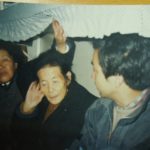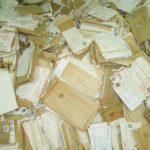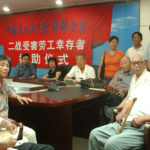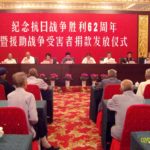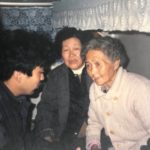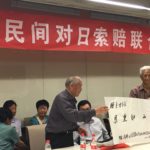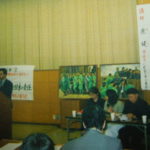Sequence number:s1135
Date of Letter:1992-06-02
Address of Author:Qinshui County, Jincheng City, Shanxi Province
Date of Event:1938-1943
Location of Event:Qinshui County, Jincheng City, Shanxi Province
Name of Author:Zhang Wanshun
Name(s) of victim(s):Common people in Qinshui County
Type of atrocity:Other Massacres, Rapes, Others(OM, RA, OT)
Other Details:During a Japanese sweep in 1943, 778 people in Qinshui County were killed by Japanese, our cattles and grains looted. In 1938, the Japanese found more than 40 people hiding in a kiln, killed all men among them and raped the women. In 1939, dozens of people were killed; in 1940, the Japanese put two gas bombs in a villager’s courtyard in the west of village and then, wearing gas masks, stabbed whoever they saw. 73 people were killed. In 1941 and 1943, the Japanese killed large groups of people. Among them, Wang Jinrong was crucified on the tree, his hands hacked; Pan Xiaobao was cut open in the belly and put under stone roller.
Mr. Tong:
How have you been?
The May 30 issue of Shangxi Daily published an article titled Civilian Compensation Wave-The Whole Story about the Chinese People Demanding Compensation Against Japan. The article highly praised you for your great act of leading thousands of Chinese victims to demand compensation for their suffering by the invading Japanese army. I deeply agree about your act and am willing to do my bit.
Like other places in China, my hometown Qinshui County was greatly suffered during Japan’s war of aggression aga inst China. The county’s records have it that in the “Three-Tier raid” in the autumn of 1943, 778 people were killed and 1,179 cattle, 333 donkeys, 5,666 sheep and 2,067 dan (1 dan is equal to 28kg in Qing Dynasty) were robbed away. The invading Japanese army occupied my county for years and committed terrible crimes of killing, burning, robbing and plundering, causing thousands of casualties. I am sending copies of several major events on the County’s records for you to read. Please tell me how to carry out the signature and compensation work so I can perform it in my county.
Best regards,
Zhang Wanshun
June 2, 1992
Education Committee of Qinshui County
Chapter 8
Atrocities of the Japanese army
The invading Japanese army killed, burned and plundered in Qinshui County during the war of aggression against China. According to the records of Shimin County, in the “Three-Tier raid” in the autumn of 1943, 778 people were killed and 1,179 cattle, 333 donkeys, 5,666 sheep and 2,067 dan (1 dan is equal to 28kg in Qing Dynasty) were robbed away.
Several major crimes of the invading Japanese army are provided below:
Section 1 Bloodbath at Xihe
On August 2, 1938, over 1,000 Japanese soldiers came from Yicheng to conduct a retaliatory raid on Guzhen, Xihe and Chenlianggou in my county. There were over 40 people hiding in a tile pit. The men were escorted to Nanbeiling and bayoneted and the women were raped in turns in the tile pit. All 8 family members of Feng Zhengxing’s were killed.
There were corpses all over the hills and valleys of Xihe, Guzhen, Chenlianggou and Shijiashan. 240 people were killed, 1,700 houses were burned down and all grain and livestock were robbed away.
Section 2 Daping Massacre
On July 9, 1939, the Japanese army was split into three troops and marched from Longhua, Yicheng to surround Daping from Nanling and Beiling of Wangzhaihe. Over 50 people were escorted to Xiaoguanshan and shot. Over 30 people including Huo Xuexin, his wife and two children and Xu Xiaodan and his wife were killed and 13 people including Liu Yulian and Li Yubao survived.
Section 3 Gas Massacre in Xishan
On July 9, 1940, over 80 people who refused to support the enemies fled from Nanpo, Lianpo, Chengguan, Yangshan and Gaolouzhuang to Xishan. The Japanese army stationed at Fuqiling suddenly surrounded Xishan and forced the people in a traditional Chinese quadrangle. Two machine guns were set up at the gate, where 6 Japanese soldiers stood, wearing gas masks and carrying bayonets. Two gas bombs were thrown into the quadrangle and then the soldiers went in to bayonet the people. Only 8 out of 81 people survived, including Ma Xifeng and Cui Xuegong. All the rest were bayoneted to death. All 46 houses were burned down.
Section 4 Bloodbath in the San Pond of Longqu
On September 24, 1941, the Japanese army forced all 83 people of Longqu in a big temple, including 78 men and 5 women. At 4 p.m. in the afternoon, 28 people were tied up and escorted to the northern hill of the village, where they were shot. Four people including Xu Bangrong survived and the rest were killed. In the second incident, 55 people were tied up and taken from the big temple to Geda temple, where they were bayoneted and pushed into the San Pond. Except Wang Wancai, who was seriously injured, all the rest 54 people were killed in San Pond.
On the next day, the Japanese army killed the remaining five people including Wang Wu, burned down 374 houses and robbed away all livestock, making Longqu a no man’s land.
Section 5 Blood Debt at Zhongxiang
On October 24, 1943, the Japanese army raided Zhongxiang Village. All villagers were forced in Guo’s quadrangle and interrogated about the whereabouts of the Eighth Route Army. The enemy didn’t obtain any useful information. On the second day, they escorted 60 villagers including Zhao Jiutun and Guan Dingfu to Niucaoling to kill them. Duan Dingfu thought that he couldn’t wait to die, so he escaped and luckily survived. Zhao Shiheng and Zhao Daohai also survived. The rest 57 people were all killed, including all family members of 3 households, 8 family members from each of 3 households, 2 family members from each of 2 households and 1 family member from each of 24 households. What a cruel massacre!
Section 6 Burning at Huaizhuang
On October 27, 1943, the Japanese army raided Huaizhuang, where they forced 56 people, men and women, old and young to Xiayaoyuan, forced them to kneel down with head on the ground and then jumped happily on their backs. Then, the soldiers forced the villagers in a pit, blocked the gate with stone, piled up dry grass at the gate and set it to fire. Instantly, the fire raged taller and wider, thick smoke spreading across the gate. Cries and shouts came from the pit. Three people rushed out of the gate and were bayoneted by the enemy. Then another 10 rushed out and were also killed. In the massacre, a total of 48 people were killed and 12 houses were burned down. Among the victims, some were from three generations of one family, some were fathers and sons and some were all family members of a household.
Section 7 Massacre at Jiaokou
Jiaokou Village was the granary of the anti-Japanese government of Qinnan. On November 1, 1943, the Japanese army suddenly raided Jiaokou. To protect the transfer of the troops, the granary keeper Wang Jinrong fell into the trap of the enemy. The enemy surrounded 67 villagers under an old ash tree in the east of the village and forced them to provide information about the grain and village cadres. The villagers didn’t say anything, so the enemy kept them in Zhang Zhanxu’s quadrangle. Then, the enemy thrust a bayonet in the chest of Zhang Guangrong, cut off his arms and threw him into a boiling pot and they cut off the hands of Wang Jinrong and crucified him on a tree. Afterwards, the soldiers returned to the quadrangle, where they butchered 39 people, set fire to the quadrangle and robbed away all cattle and sheep.
Section 8 Massacre at Langbi and Xiliang
On September 26, 1943, the Japanese army raided Langbi. Farmer Cui Zhishen from Nanlang Village witnessed the massacre and recorded the atrocities of the Japanese army in the form of rhymes.
On September 26, 1943, the Japanese soldiers arrived at Nange.
A man named Dou Shouyin from Nanlang was killed at Nange.
The Japanese soldiers moved forward to kill at Dayangou.
They killed Zhou Miao’s mother Haixing and Chao Lan’s father.
After killing Chang Wenqi at Gemaping, they reached Wodi.
After bayoneting Shuangzheng’s mother, they angrily came to Xilang.
They captured Taoist priest Tu Yuantang and killed him in a well.
An old man surnamed Chang from Donglang made a verse.
He said, “Eat well, wear badly and run slowly when the Japanese came.
One day he saw Japanese soldiers at Gongmenkou and walked slowly.
The soldiers saw him and shot, and he fell and died.
A man named Cui Yuxiu from Nanlang escaped to Zaoqigou.
Three out of his four family members had been killed.
All family members of brothers Cui Yuli and Cui Yuzhuo were captured.
Seven out of all eight people were killed.
Only Xiaomi survived.
The mother and wife of Cui Jinghe from Shangyuantou were killed.
Two daughters were bayoneted, but survived by faking death.
Cui Jingzeng from Shangtouyuan was killed at Gouwagen.
His uncle Cui Chaomeng was killed at Shengouge Cave.
A man named Cui Douyin from Gedong always said “Imperial Army”.
He led the way to the south and was killed by the river of Liu Village.
Setting Xilang and Nanlang aside, let’s talk about He’nanzhuang.
The Japanese robbed and raped; each woman would remember.
They lived at Xilang Village and committed more cruel crimes there.
Cui Jingren and Zhang Hongjun were killed in a latrine.
Wang Wu and Guan Wang from Donglang were killed on street of Xiliang.
Tian Lilun from Xilang was captured and killed in a water tank.
The Japanese soldiers then returned from Wangbi to Xiliang.
Guo Jinxiu was captured at Hexi and thrown off a cliff.
Wang Shilong and Wang Fengting were thrown into Qin River.
Wang Xiaoqing failed to escape and was hung on a tree and burned.
Fengwen, Fenggao, Shiyi and Guo Jinghuan were thrown into a latrine.
The Japanese killed countless people and that will be remembered.
Section 9 Blood Debt at Yinzhuang
On October 25, 1943, the Japanese army began to raid Qindong. They started from Douzhuang and captured 44 people along the way. The Japanese soldiers took them to Hetan, Yinzhuang, where the people were thrown into a well or latrine. Only Liu Hushan survived. On the next day, the Japanese army captured over 50 people at Jiafeng and 28 at Weichi Village. After they reached Wangchuan Village, Yancheng, 3 people including Zhao Jie, a former soldier from the No. 2 Regiment and Zhao Xiaodong from Weichi Village escaped. The rest 72 people were forced into a latrine and the Japanese soldiers threw stone at them and set them to fire (one person survived). Moreover, the Japanese army bayoneted the 73-year-old Lv Xingfu at Weichi Village, buried widower Lv Jiu alive, killed the 21-year-old Zhang Xiaoliu with stone, opened the belly of brothers Pan Xiobao and Pan Xiaode and then ground them with stone. The inhuman massacre committed by the Japanese army will never be forgotten by the Chinese people.
Section 10 Massacre at Zhupigou
On September 27, 1943, 21 wounded Chinese soldiers of No. 386 Brigade of the Eighth Route Army were moved from Shazhuang Village to Zhupigou, Guduinanshan. On the same day, the Japanese army marched from Anzeduo to attack the field hospital at Shazhuang Village and failed. Then, they surrounded Zhupigou, bayoneted all 21 wounded Chinese soldiers to death and robbed away the troops’ supplies such as clothes and cloths.
Attached:
Japanese Puppet Organization
The Japanese puppet army of Qinshui County was named the No. 2 Group of No. 314 Regiment, stationed at Xiguan. The army of over 300 soldiers was led by XX TATSUOKA and XX MOTOBE. The army set up the security troops, gendarmerie and plainclothes troops and organized the suppression corps in 1942.
- Gendarmerie: the Japanese military authority that specialized in reconnaissance and interrogation. It consisted of over 30 people and was led by Cui Chizhong (from Langbi).
- Security troops: the Japanese puppet army that cooperated with the Japanese army in a raid to destroy anti-Japanese bases. The troops originally had only 43 people and were led by Zhang Linxiu and Gao Chenglu. The security guards were sent to different villages in the autumn of 1940.




